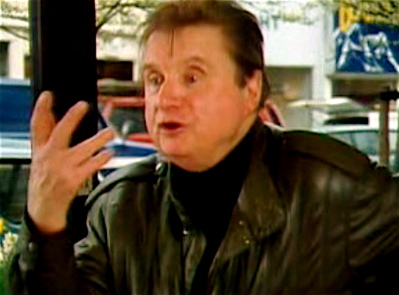
The current (brilliant) retrospective of Francis Bacon at Tate Britain ends with a montage of filmed interviews the artist gave, largely with David Sylvester as part of his extended sequence of interviews with the artist, which drew me back to thinking about artists on film in the pre-Art:21 days. Bacon’s televisual presence gives, I think, a greater understanding of his work as self-reflexive and theatrical in a way that isn’t often discussed in the extensive writing about the artist. Extracts from a 1985 interview with Bacon reveal him to be acutely aware of his own (to him negligible) stature as an artist, and he sits in the soon-to-be-defunct Colony Room in Soho looking and sounding every inch the disdainful nihilist/hedonist of popular legend, in his boho scarf and geography-teacher jacket. What’s unusual about Bacon in these films is his slightly camp self-awareness. In print his many aphorisms look viciously misanthropic; on film, there’s something avuncular, even cuddly, about his resting-actor hamminess and pantomime pessimism. A famous quote of Bacon’s often used to illustrate his supposed gruesomeness (“I’ve always hoped in a sense to be able to paint the mouth like Monet painted a sunset”) is somewhat sheepishly amended (in a compelling early Sylvester interview in 1966) with “I’d like to paint a smile too, but I can’t quite get it right.”
By contrast, Bacon’s near-contemporary (and kindred spirit, in a way) Willem de Kooning, comes off as somewhat awkward, uneasy in front of the camera, describing himself as a “country dumpling” in Hans Namuth’s 1964 film. Namuth’s 1951 film of Jackson Pollock remains instructive, not as intended (to demystify or perhaps justify to the viewing public the artist’s ‘dripping’ technique), but as epitaph to a division between public and private personas. Pollock stomps around, frowning, both aware of the camera and apparently fearful of how he’ll be seen, like an actor concentrating on remembering his lines but terrified he’ll mess them up.
Andy Warhol’s appearances on television can be seen (as they are in the current retrospective of his work at the Hayward Gallery) as part of his body of work as a whole. Answering a sequence of questions in a 1964 interview, his responses remain as curt and affectless (and likewise studiedly so–he gives a little smirk at one point) as his paintings, sculptures, films and photographs. In looking at these films in sequence, there’s a sense of a relationship between art and its audience undergoing a subtle shift, a sort of coming of age, not to be rewound.




Pingback: Letter from London: War(hol)! What is he good for? | Art21 Blog